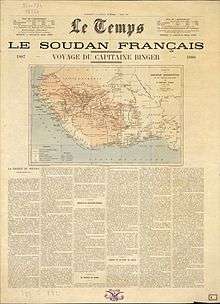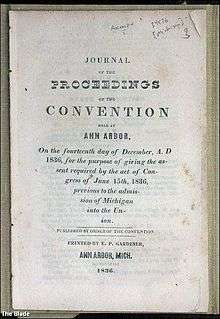Didone (typography)
Didone is a genre of serif typeface that emerged in the late 18th century and is particularly popular in Europe. It is characterized by:
- Narrow and unbracketed (hairline) serifs. (The serifs have a constant width along their length.)
- Vertical orientation of weight axes. (The vertical strokes of letters are thick.)
- Strong contrast between thick and thin lines. (Horizontal parts of letters are thin in comparison to the vertical parts.)
- Some stroke endings show ball terminals. (Many lines end in a teardrop or circle shape, rather than a plain wedge-shaped serif.)
- An unornamented, "modern" appearance.
The category is also known as modern or modern face serif fonts, in contrast to old style serif designs, which date to the Renaissance period.
History
.jpg)


Didone types were developed by printers including Firmin Didot, Giambattista Bodoni and Justus Erich Walbaum, whose eponymous typefaces, Bodoni, Didot, and Walbaum, remain in use today. Their goals were to create more elegant, classical designs of printed text, developing the work of John Baskerville in Birmingham and Fournier in France towards a more extreme, precise design with intense precision and contrast, that could show off the increasingly refined printing and paper-making technologies of the period.[1][2][3] These trends were also accompanied by changes to page layout conventions and the abolition of the long s.[4][5][6][7][8][9] Historian Talbot Baines Reed called the style "trim, sleek, gentlemanly, somewhat dazzling".[10]
In Britain and America, the lasting influence of Baskerville led to the creation of types such as Bell and Scotch Roman designs, in the same spirit as Didone fonts from the continent but less geometric; these like Baskerville's type are often called transitional serif designs.[11][lower-alpha 1] Later developments of this class have been called Scotch Modern and show increasing Didone influence.[13]


The nineteenth century also saw the arrival of bold type, first for headings, titles and posters, then for emphasis within body text, and while neither Didot nor Bodoni cut bold type for this latter use themselves, many Didone bold types were created by their successors.[14][15] A particular development in this direction was the poster type genre known as 'fat faces', extremely bold designs intended for posters and signage.[16][17] It matched the desire of advertisers for eye-catching new kinds of letters that were not merely enlarged forms of body text fonts.[18]
While printers often used Didone typefaces, some "old style" faces continued to be sold and new ones developed by typefounders.[19] From around the 1840s onwards, interest began to develop among artisanal printers in the typefaces of the past.[20][21][22][23]
A revival of interest in the old styles of letter around 1870 was criticised by master signpainter James Callingham in his contemporary textbook on the art:
It is...marvellous to think that, after the much desiderated correction [to letters] had been applied, an attempt should recently have been made to introduce these old irregular letters again to the public notice, for the vagaries of fashion have of late brought into use in the printing trade several kinds of old-faced types...and the infection has in some degree been caught by the sign-writer...we have thus, one the one hand, a hard, an irregular and unfinished letter; and on the other, a graceful, symmetrical and highly finished letter...there is some indication that this absurdity, like all fashions that have their birth in bad taste, is happily passing away, and the modern letter is again asserting its superiority. It has always been the case in the arts that, after periods of extravaganza and bizzarerie, there has been a recurrence to sound taste. Positive retrogession is against nature and any tendency in this direction will most assuredly correct itself. The adherents of the old irregular alphabets, which were made so because scarcely anyone was capable of making them better, might just as reasonably advocate a return to the rough and unplaned machinery of the first locomotive steam engines, taking as their model the old "Puffing Billy", now so carefully preserved in the Patent Museum at South Kensington.[24]
Displacement
Didone fonts began to decline in popularity for general use, especially in the Anglosphere, around the end of the nineteenth century. The rise of the slab serif and sans-serif genres displaced Didone type from much display use, while the revival of interest in "old-style" designs reduced its use in body text. This trend, influenced by the Arts and Crafts movement, rejected austere, classical designs of type, ultimately in favour of gentler designs.[23][19] Some of these were revivals of typefaces from between the Renaissance and the late eighteenth century such as revivals (with varying levels of faithfulness to the originals) of the work of Nicolas Jenson, William Caslon's "Caslon" typefaces and others such as Bembo and Garamond. Others such as "Old Styles" from Miller and Richard, Goudy Old Style and Imprint were new designs on the same pattern.[25]
An early example of the distaste some printers had for the modern type style was French printer Louis Perrin, who would eventually commission some new typeface designs on a traditional model.[26][27] He wrote in 1855:
You ask me what kind of whim leads me to revive types of the sixteen century today…I often have to reprint old poetry [from the sixteenth century] and this task invariably makes me oddly uneasy. I cannot recognise in my proofs the verses…our present day punches, which are so precise, so correct, so regularly aligned, so mathematically symmetrical…no doubt have their merits, but I should prefer to see them kept for printing reports on the railway.[28]

Frederic Goudy, an Arts and Crafts movement-inspired printer turned type designer, had similar reservations about the lettering style. While he mentioned Bodoni in his book Elements of Lettering, he wrote that it was a style "for which the writer cannot develop any enthusiasm", adding: "his pages [had] the brilliance of a fine engraving. The writer dislikes Bodoni's types, because none of them seem free from a feeling of artificiality"[29] As an experiment in this period, Goudy attempted to 'redeem' Didone capitals for titling purposes by leaving a white line in the centre of the thick strokes. He hoped this design, Goudy Open, would leave a lighter colour (density of ink) on the paper.[29][30]
Nonetheless, Didone designs have remained in use, and the genre is recognised on the VOX-ATypI classification system of typefaces and by the Association Typographique Internationale (AtypI).[31] The genre remains particularly popular for general-purpose use in the printing of Greek, as the Didot family were among the first to set up a printing press in the newly independent country, and in mathematics, as the standard mathematical typesetting programmes TeX and LaTeX use the Computer Modern family as default, to produce an effect explicitly inspired by nineteenth-century scientific printing.[32][33]
Among popular faces in modern use, the typeface family Century is inspired by later American Didone designs, although compared to many in the Didone genre it has quite a low level of stroke contrast, suitably for its purpose of high legibility in body text. Typefaces of the period have often been revived since for cold type and digital composition, while modern typefaces along the same lines include Filosofia and the open-source Computer Modern. Some later Didone families have focused on subgenres of the period, such as Surveyor, inspired by labels on maps, and Morris Fuller Benton's Ultra Bodoni and Matthew Carter's Elephant, reinterpretations of 'fat face' designs.[17]
Usage

In print, Didone fonts are often used on high-gloss magazine paper for magazines such as Harper's Bazaar, on which the paper retains the detail of their high contrast well, and for whose image a crisp, 'European' design of type may be considered appropriate.[34] They are used more often for general-purpose body text, such as book printing, in Europe.
The effective use of digital Didone typefaces poses unique challenges. While they can look very elegant due to their regular, rational design and fine strokes, a known effect on readers is 'dazzle', where the thick verticals draw the reader's attention and cause them to struggle to concentrate on the other, much thinner strokes that define which letter is which.[8][35][36] For this reason, using the right optical size of digital font has been described as particularly essential with Didone designs.[37] Fonts to be used at text sizes will be sturdier designs with thicker 'thin' strokes and serifs (less stroke contrast) and more space between letters than on display designs, to increase legibility.[38][39] Optical sizes were a natural requirement of printing technology at the time of Didone typefaces' first creation in metal type, since each size of metal type would be custom-cut, but declined as the pantograph, phototypesetting and digital fonts made printing the same font at any size simpler; a revival has taken place in recent years.[40][41] French designer Loïc Sander has suggested that the dazzle effect may be particularly common in designs produced in countries where designers are unfamiliar with how to use them effectively and may choose Didone fonts designed for headings.[42] Many modern Didone digital revivals intended for professional printing, such as Parmagiano, ITC Bodoni and Hoefler & Frere-Jones' Didot and Surveyor, have a range of optical sizes, but this is less common on default computer fonts.[42][43][44][45] Among default Didone fonts on computer systems, Century Schoolbook on Windows is oriented towards body text use, while the Didot revival on OS X was specifically intended for display use and not for body text.
Derivatives

The shape of nineteenth-century Didone designs, with their narrow apertures, has been suggested as a major influence on many early sans-serif fonts such as Akzidenz-Grotesk and its derivatives such as Helvetica, developed in Europe some years after their introduction.[46] An example of this influence is the narrow apertures of these designs, in which strokes on letters such as a and c fold up to become vertical, similar to what is seen on Didone serif fonts.[47]
Matthew Carter's Scotch Roman-inspired computer font Georgia is notable as an extremely distant descendent of Didone typefaces. In Georgia, the stroke contrast is greatly reduced and the bold made much bolder than normal in order for the design to render well on a low-resolution computer monitor, but the general letter shape and ball terminals of Scotch Roman designs are preserved. He also developed the Scotch Roman revival Miller for print use.[48] Given these unusual design decisions, Matthew Butterick, an expert on document design, recommended that organizations using Georgia for onscreen display license Miller to achieve a complementary, more balanced reading experience on paper.[49][50]
Reverse-contrast styles

An eccentric method of reworking and parodying Didone typefaces has long been to invert the contrast, making the thin strokes thick and the thick strokes thin.[51][52] First seen around 1821 in Britain and occasionally revived since, these are often called reverse-contrast fonts. They effectively become slab serif designs because of the serifs becoming thick. In the 19th century, these designs were called Italian because of their exotic appearance, but this name is problematic since the designs have no clear connection with Italy; they do slightly resemble capitalis rustica Roman writing, although this may be a coincidence. They were also called Egyptian, an equally inauthentic term applied to slab serifs of the period.[53][54]
Intended as attention-grabbing novelty display designs more than as serious choices for body text, within four years of their introduction the printer Thomas Curson Hansard had described them as 'typographic monstrosities'.[55] Nonetheless, somewhat toned-down derivatives of this style persisted in popular use throughout the nineteenth century, and are commonly associated with 'wild west' printing on posters.[56][57] They ultimately became part of the Clarendon genre of slab-serif typefaces, and these later designs are often called called French Clarendon designs.[58]
References
- ↑
 Chisholm, Hugh, ed. (1911). "Bodoni, Giambattista". Encyclopædia Britannica (11th ed.). Cambridge University Press.
Chisholm, Hugh, ed. (1911). "Bodoni, Giambattista". Encyclopædia Britannica (11th ed.). Cambridge University Press. - ↑
 Rines, George Edwin, ed. (1920). "Bodoni, Giambattista". Encyclopedia Americana.
Rines, George Edwin, ed. (1920). "Bodoni, Giambattista". Encyclopedia Americana. - ↑ Johnson, A. F. (1930). "The Evolution of the Modern-Face Roman". The Library. s4-XI (3): 353–377. doi:10.1093/library/s4-XI.3.353.
- ↑ Mosley, James. "Long s". Type Foundry. Retrieved 11 August 2015.
- ↑ Wigglesworth, Bradford, Lieber (1830). Encyclopædia Americana - Didot. Carey, Lea & Carey.
- ↑ Bodoni, Giambattista. Columbia Electronic Encyclopedia, 6th Edition [serial online]. January 2009:1-1. Available from: Academic Search Premier, Ipswich, MA. Accessed August 7, 2009.
- ↑ Shaw, Paul. "Overlooked Typefaces". Print magazine. Retrieved 2 July 2015.
- 1 2 Cees W. De Jong, Alston W. Purvis, and Friedrich Friedl. 2005. Creative Type: A Sourcebook of Classical and Contemporary Letterforms. Thames & Hudson. (223)
- ↑ . p. 362. ISBN 3038212601. Missing or empty
|title=(help) - ↑ Reed, Talbot Baines (1890). "Old and New Fashions in Typography". Journal of the Society of Arts. 38: 527–538. Retrieved 17 September 2016.
- ↑ Phinney, Thomas. "Transitional & Modern Type Families". Graphic Design and Publishing Centre. Retrieved 10 August 2015.
- ↑ Eliason, Craig (October 2015). ""Transitional" Typefaces: The History of a Typefounding Classification". Design Issues. 31 (4): 30–43. doi:10.1162/DESI_a_00349.
- ↑ Shinn, Nick. "Modern Suite" (PDF). Shinntype. Retrieved 11 August 2015.
- ↑ Eskilson, Stephen J. (2007). Graphic design : a new history. New Haven: Yale University Press. p. 25. ISBN 9780300120110.
- ↑ Hoefler, Jonathan. "Didot history". Hoefler & Frere-Jones. Retrieved 11 August 2015.
- ↑ Phinney, Thomas. "Fat faces". Graphic Design and Publishing Centre. Retrieved 10 August 2015.
- 1 2 Kennard, Jennifer. "The Story of Our Friend, the Fat Face". Fonts in Use. Retrieved 11 August 2015.
- ↑ Frere-Jones, Tobias. "Scrambled Eggs & Serifs". Frere-Jones Type. Retrieved 23 October 2015.
- 1 2 Mosley, James. "Recasting Caslon Old Face". Type Foundry. Retrieved 1 August 2015.
- ↑ Ovink, G.W. (1971). "Nineteenth-century reactions against the didone type model - I". Quaerendo. 1 (2): 18–31. Retrieved 20 February 2016.
- ↑ Ovink, G.W. (1971). "Nineteenth-century reactions against the didone type model - II". Quaerendo. 1 (4): 282–301. Retrieved 20 February 2016.
- ↑ Ovink, G.W. (1 January 1972). "Nineteenth-century reactions against the didone type model-III". Quaerendo. 2 (2): 122–128. doi:10.1163/157006972X00229.
- 1 2 Johnson, A.F. (1931). "Old-Face Types in the Victorian Age" (PDF). Monotype Recorder. 30 (242): 5–15. Retrieved 14 October 2016.
- ↑ Callingham, James (1871). Sign Writing and Glass Embossing.
- ↑ Lawson, A. (1990). Anatomy of a typeface. Boston: Godine, p.200.
- ↑ Devroye, Luc. "Louis Perrin". Type Design Information. Retrieved 20 February 2016.
- ↑ Savoie, Alice. "Louize - typeface review". Typographica. Retrieved 20 February 2016.
- ↑ Mosley, James (2003). "Reviving the Classics: Matthew Carter and the Interpretation of Historical Models". In Mosley, James; Re, Margaret; Drucker, Johanna; Carter, Matthew. Typographically Speaking: The Art of Matthew Carter. Princeton Architectural Press. pp. 31–34. ISBN 9781568984278. Retrieved 30 January 2016.
- 1 2 3 Goudy, Frederic (1922). Elements of Lettering. New York: Mitchell Kennerley. pp. 34–5 & 40. Retrieved 3 September 2015.
- ↑ "LTC Goudy Open". LTC. Myfonts. Retrieved 26 August 2015.
- ↑ Campbell 2000, p.173
- ↑ John D. (ed.). Berry (2002). Language Culture Type: International Type Design in the Age of Unicode. ATypI. pp. 82–4. ISBN 978-1-932026-01-6.
- ↑ "GFS Didot". Greek Font Society. Retrieved 10 August 2015.
- ↑ "HFJ Didot introduction". Hoefler & Frere-Jones. Retrieved 10 August 2015.
- ↑ Berkson, William. "Reviving Caslon, Part 2". I Love Typography. Retrieved 21 September 2014.
- ↑ Katz, Joel (2012). Designing information : human factors and common sense in information design. Hoboken, NJ: Wiley. p. 140. ISBN 9781118420096.
- ↑ Coles, Stephen. "Trianon review". Identifont. Retrieved 10 August 2015.
- ↑ "HFJ Didot". Hoefler & Frere-Jones. Retrieved 10 August 2015.
- ↑ Sowersby, Kris. "Why Bembo Sucks". Retrieved 30 June 2015.
- ↑ Ahrens and Mugikura. "Size-specific Adjustments to Type Designs". Just Another Foundry. Retrieved 21 November 2014.
- ↑ Coles, Stephen. "Book Review: Size-specific Adjustments to Type Designs". Typographica. Retrieved 21 November 2014.
- 1 2 Sander, Loïc. "Parmigiano review". Typographica. Retrieved 10 August 2015.
- ↑ Twemlow, Alice. "Forensic Types". Eye Magazine. Retrieved 6 October 2014.
- ↑ "Surveyor overview". Hoefler & Frere-Jones. Retrieved 11 August 2015.
- ↑ McNaughton, Melanie. "Martha Stewart's Graphic Design for Living". Academia.edu. Retrieved 7 October 2014.
- ↑ My Type Design Philosophy by Martin Majoor
- ↑ Spiekermann, Erik. "Helvetica Sucks". Spiekermann blog. Retrieved 15 July 2015.
- ↑ Middendorp, Jan. "Matthew Carter interview". MyFonts. Monotype. Retrieved 11 July 2015.
- ↑ Butterick, Matthew. "Miller".
- ↑ "Miller". Font Bureau. Retrieved 11 July 2015.
- ↑ Barnes & Schwarz. "Type Tuesday". Eye. Retrieved 10 August 2015.
- ↑ Devroye, Luc. "Henry Caslon". Retrieved 10 August 2015.
- ↑ Bilak, Peter. "Beauty and Ugliness in Type design". I love typography. Retrieved 10 August 2015.
- ↑ De Vinne, Theodore Low, The Practice of Typography, Plain Printing Types, The Century Co., N.Y.C., 1902, p. 333.
- ↑ Hansard, Thomas Carson (2003). Typographia : an historical sketch of the origin and progress of the art of printing. Bristol: Thoemmes. ISBN 1843713659.
- ↑ Provan, Archie, and Alexander S. Lawson, 100 Type Histories (volume 1), National Composition Association, Arlington, Virginia, 1983, pp. 20-21.
- ↑ "P.T. Barnum". MyFonts.
- ↑ Challand, Skylar. "Know your type: Clarendon". IDSGN. Retrieved 13 August 2015.
Further reading
- Valerie Lester, Giambattista Bodoni: His Life and His World (2015)
- T. M. Cleland, "Giambattista Bodoni of Parma". (1916)
- Stephen Coles, "The Didot you didn't know". (2004)
